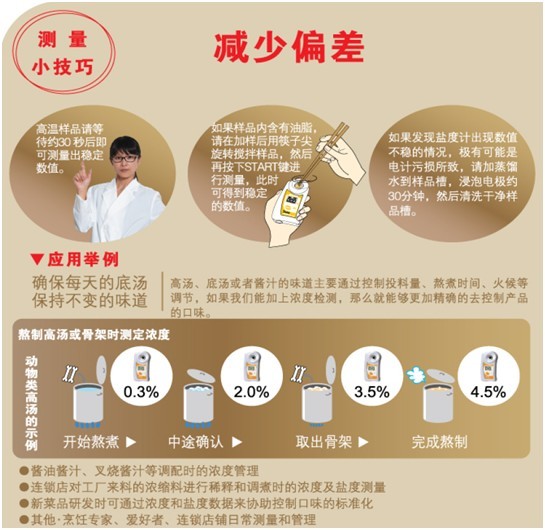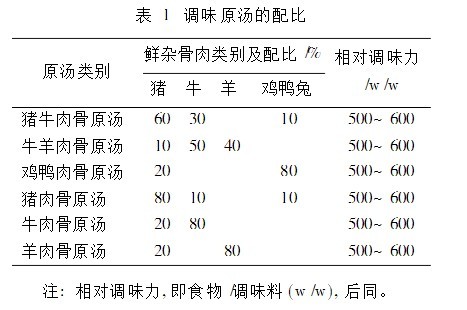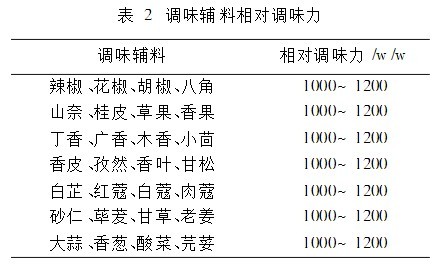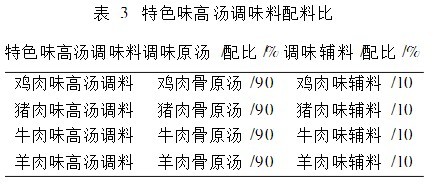The first step is to put the meat into the soup. The degree of delicacy of the soup needs attention to the use of oil and protein conditioning. After that, it is appropriate to put some spices, according to personal taste is more important. Sauces and extracts (stocks) dissolved in the soup are equal to the content of all substances. In order to always maintain the exquisite taste of the traditional soup stock, the characteristic soup stock uses a densitometer to measure and become a common-sense habit and an indispensable tool in the measurement of salinity. Seasonal changes in concentration and salinity can also produce subtle changes. Scientific tests are used to measure daily concentrations and salinity to make up for the lack of chef experience and intuition to ensure consistent taste.

1 Materials and Methods
A. Raw materials and instruments
Pigs, cows, sheep, chickens, ducks and rabbits, such as fresh bone, meat, ginger, garlic, sauerkraut, star anise, Sannai, cinnamon and cloves and other spices are commercially available.
Saline salinity meter , soup concentration meter, scale soup MASTER- Ramen M ,
B. Preparation process
Fresh meat, bone → Stew → Separation → Concentrate → Determination → Conditioning → Seasoning soup
By using the refractometry method, the relative seasoning salinity of the extracts of each seasoning was measured and adjusted to become seasoning accessories. Using the PAL- Ramen Salinometer , place a few drops of the soup sample into the prism tank. Press the START button to display the measured values ​​and the measured temperature. The salinity of the soup can be obtained. Drop a few drops of soup sample on the sample prism, cover the solar cover, and then confirm that the sample has been evenly spread on the surface of the prism, cover the daylight cover, observe the value through the eyepiece, read the value of the boundary line position, at any time The concentration and salinity values ​​of the soup can be obtained, and the thick soup is tested for changes in salinity and concentration.
C. Preparation of stock seasoning
The content and condition of flavoring ingredients in soup seasoning are adjusted according to the taste sensation of humans and the requirements of conventional cooking seasoning; the flavor type of soup seasoning is determined based on traditional food customs and dishes; the seasoning of soup seasoning is related to the compatibility of main and auxiliary ingredients. The relationship with the regular cuisine flavor characteristics.
The relative seasoning power of various flavoring raw soups and seasoning accessories is used as the reference blending amount of various flavor types of soup seasoning, and the relevant seasoning soup and seasoning accessories are allocated according to the application relationship between main season and auxiliary materials related to stock seasoning. Condiment flavored soup stock seasoning
The proportion of seasoning soup is shown in Table 1.

The relative seasoning power of seasoning accessories is shown in Table 2

The ratio of ingredients for special flavor soup seasoning is shown in Table 3

In the seasoning process of traditional seasoning broth, traditional soup stocked with animal raw materials is used to make seasoned soup and then flavor ingredients of seasonings are added to prepare a new soup stock with strong seasoning power, versatility, and ease of use. seasoning.
In summary , the seasoning ability of soup seasoning is strong, the efficiency is high, the usage is simple, and the consistent deliciousness is ensured . The salinity measurement has a certain value and it is precisely to control the taste of soup products.
ATAGO ( Audio ) Marketing Department (Xuan)
Self Priming System Pump Sets,Self Priming Pumps,Self-Priming Centrifugal Pump,Water Pump Set
Bin-Bridge General Machinery Co.,Ltd , https://www.castingpump.com
